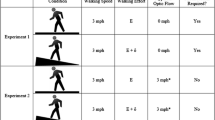Abstract
The optic flow generated in the eyes during self-motion provides an important control signal for direction and speed of self-motion, and can be used to track the distance that has been traveled. The use of vision for these behavioral tasks can be studied in isolation in virtual reality setups, in which self-motion is merely simulated, and in which the visual motion can be controlled independently of other sensory cues. In such experiments it was found that the estimation of the travel distance of a simulated movement shows characteristic errors, sometimes overestimating and sometimes underestimating the true travel distance. These errors can be explained by a leaky path integration model. To test whether this model also holds for actual self-motion in the real world we studied walking distance perception in an open field with tasks similar to those previously used in virtual environments. We show that similar errors occur in the estimation of travel distance in the real world as in virtual environment, and that they are consistent with the leaky integration model.


Similar content being viewed by others
References
Bremmer F, Lappe M (1999) The use of optical velocities for distance discrimination and reproduction during visually simulated self-motion. Exp Brain Res 127(1):33–42
Calow D, Lappe M (2008) Efficient encoding of natural optic flow. Network Comput Neural Syst 19(3):183–212
Frenz H, Bremmer F, Lappe M (2003) Discrimination of travel distances from ‘situated’ optic flow. Vis Res 43(20):2173–2183
Frenz H, Lappe M (2005) Absolute travel distances from optic flow. Vis Res 45(13):1679–1692
Frenz H, Lappe M (2006) Visual distance estmation in static compared to moving virtual scenes. Span J Psychol 9(2):321–331
Frenz H, Lappe M, Kolesnik M, Bührmann T (2007) Estimation of travel distance from visual motion in virtual environments. ACM Trans Appl Percept 3(4):419–428
Fukusima SS, Loomis JM, DaSilva JA (1997) Visual perception of egocentric distance as assessed by triangulation. J Exp Psychol Hum Percept Perform 23(1):86–100
Glasauer S, Schneider E, Grasso R, Ivanenko YP (2007) Space-time relativity in self-motion reproduction. J Neurophysiol 97(1):451–461
Knapp JM, Loomis JM (2004) Limited field of view of head-mounted displays is not the cause of distance underestimation in virtual environments. Presence 13(5):572–577
Lappe M (2000) Computational mechanisms for optic flow analysis in primate cortex. In Lappe M (ed) Neuronal processing of optic flow volume 44 of International Review of Neurobiology. Academic Press, London, pp 235–268
Lappe M, Bremmer F, van den Berg AV (1999) Perception of self-motion from visual flow. Trends Cogn Sci 3(9):329–336
Lappe M, Frenz H, Bührmann T, and Kolesnik M (2005) Virtual odometry from visual flow. In: Rogowitz BE, Pappas TN, Daly SJ (eds) Human vision and electronic imaging X volume 5666. Proceedings of the SPIE/IS&T conference on human vision and electronic imaging, vol X, pp 493–502
Lappe M, Hoffmann K-P (2000) Optic flow and eye movements. In: Lappe M (ed) International reviev of neurobiology volume 44 neuronal processing of optic flow. Academic Press, New York, pp 29–47
Lappe M, Jenkin M, Harris LR (2007) Travel distance estimation from visual motion by leaky path integration. Exp Brain Res 180:35–48
Lee DN (1980) The optic flow field: the foundation of vision. Philos Trans R Soc Lond B Biol Sci 290:169–179
Loomis JM, Da Silva JA, Fujita N, Fukusima SS (1992) Visual space perception and visually directed action. J Exp Psychol Hum Percept Perform 18(4):906–921
Loomis JM, Klatzky RL, Golledge RG, Philbeck JW (1999) Human navigation by path integration. In Golledge RG (ed) Wayfinding: cognitive mapping and other spatial processes. Johns Hopkins, Baltimore, pp 125–151
Maurer R, Seguinot V (1995) What is modelling for? A critical review of the models of path integration. J Theor Biol 175:457–475
Mittelstaedt H, Mittelstaedt ML (1973) Mechanismen der Orientierung ohne richtende Außenreize. Fort Zool 21:46–58
Mittelstaedt M, Mittelstaedt H (2001) Ideothetic navigation in humans: estimation of path length. Exp Brain Res 139:318–332
Mittelstaedt ML and Glasauer S (1991) Idiothetic navigation in gerbils and humans. Zool Jb Physiol 95(3/4):427–435
Peruch P, May M, Wartenberg F (1997) Homing in virtual environments: effects of field of view and path layout. Perception 26(3):301–311
Redlick FP, Jenkin M, Harris LR (2001) Humans can use optic flow to estimate distance of travel. Vis Res 41:213–219
Riecke BE, van Veen HAHC, Bülthoff HH (2002) Visual homing is possible without landmarks: a path integration study in virtual reality. Presence 11:443–473
Rieser JJ, Ashmead DH, Talor CR, Youngquist GA (1990) Visual perception and the guidance of locomotion without vision to previously seen targets. Perception 19(5):675–689
Sahm CS, Creem-Regehr SH, Thompson WB, Willemsen P (2005) Throwing versus walking an indicators of distance perception in similar real and virtual environments. ACM Trans Appl Percept 2(1):35–45
Sun H-J, Campos JL, Chan GSW (2004) Multisensory integration in the estimation of relative path length. Exp Brain Res 154(2):246–254
Thompson WB, Willemsen P, Gooch AA, Creem-Regehr SH, Loomis JM, Beall AC (2004) Does the quality of the computer graphics matter when judging distances in visually immersive environments? Presence 13(5):560–571
Acknowledgments
The authors wish to thank Irina Kaltwasser and Philipp Hintze for their help in data collection. M.L. gratefully acknowledges support form the SFB 509 Neurovision, the German Science Foundation DFG LA-952/3, the German Federal Ministry of Education and Research project Visuo-spatial Cognition, and the EC Projects Drivsco and Eyeshots.
Author information
Authors and Affiliations
Corresponding author
Rights and permissions
About this article
Cite this article
Lappe, M., Frenz, H. Visual estimation of travel distance during walking. Exp Brain Res 199, 369–375 (2009). https://doi.org/10.1007/s00221-009-1890-6
Received:
Accepted:
Published:
Issue Date:
DOI: https://doi.org/10.1007/s00221-009-1890-6




